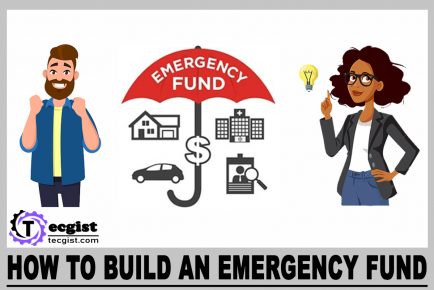Having an Emergency Fund saved up for times of need is essential. Think of it like a cushion for when unexpected things happen in life. This helps you avoid debt, especially if you already owe money. It is essential to build an Emergency Fund to be prepared for difficult situations like the COVID-19 pandemic.
The Emergency Fund can offer you financial stability and a sense of security, as it is a safety cushion in case of unforeseen events.

Keep reading to learn how to start saving for your emergency fund and how much you should aim to have saved up. This page’s information will help you answer the following questions concerning what an emergency fund is, how you build it, why you need it, where to keep it, and when is the best time to use it.
What is an Emergency Fund
An emergency fund is like a savings account where you keep money saved up for big surprise expenses, like:
- Unexpected medical bills.
- Fixing or replacing broken home appliances.
- Major repairs for your car.
- Money to cover you if you lose your job.
Why You Need an Emergency Fund
Having some extra cash saved up for emergencies is good for more than just financial stability. Below you will find the benefits of having emergency funds.
Benefits of Emergency Funds
- It helps you stay calm
Having a safety net helps reduce stress. Unexpected events can hurt your money and worry you. Without a backup plan, you’re living on the edge financially, hoping nothing wrong happens.
Having an emergency fund means you’re ready for any surprise life throws at you. It helps you handle unexpected events without stressing about money.
- It helps you avoid spending money recklessly
Well, it’s a good idea to keep your emergency money in a place where you won’t be tempted to spend it on non-essential things like fancy clothes or TVs. If your cash is easily accessible through your debit card, you might use it for things you don’t really need.
By keeping your emergency money in a separate place, you make it harder to spend impulsively. Plus, having it in a different account helps you keep track of how much you have saved and how much more you might need to save.
- It helps you avoid making poor choices with your money
There might be other ways to get money fast, like borrowing, but they come with costs. You have to pay interest, fees, and penalties, which can add up.
How to Build an Emergency Fund
If you do not know how to build or where to start building your emergency fund, this is a guide on how to do that.
1. Create a budget to figure out where you can save more money.
Budgeting means tracking your money and spending less. A survey found that 13% of people want to budget better in 2024. To save money, you need to know where you spend it.
Budgeting helps you use your money wisely and find ways to spend less. You can use Bankrate’s Home Budget Calculator to make a budget. A budgeting app is also helpful. It adds up your money and expenses, showing your financial situation on one screen.
2. Figure out how much money you need for emergencies.
Figuring out how much your family needs for important stuff is important for setting your emergency fund target. A budget is like a map of your spending. It shows how much money you need every month for things like rent, food, and transportation.
To find out how much you need for six months, add up all these costs and then multiply the total by six. That’s the amount you need to cover six months of expenses. It might take a while for most families to save up that much.
3. Set up a paycheck to be directly sent to your bank account.
Direct deposit means your paycheck and other money are put directly into your bank account without you having to do anything. You don’t have to go to the bank to cash a check.
You can choose to divide the money into different accounts, like putting some in your emergency fund and the rest in your regular account. Some apps can also move some of your money into savings automatically. Doing this makes saving easier and helps you reach your savings goals.
4. Save extra money you didn’t expect
A financial windfall means getting a lot of money unexpectedly. According to the American Institute of Certified Public Accountants, 70% of people who get a windfall spend it all within a few years.
If you get a windfall, it’s a good idea to put some of it into an emergency fund, unless you already have enough saved up. Unexpected money could be from things like a tax refund, bonus, gift of cash, inheritance, or winning a contest or the lottery.
5. Continue to save even after you’ve achieved your target.
As of 2022, the average yearly cost of living is $72,967, according to the BLS. It’s smart to save more money for emergencies, like job loss or illness. If you have extra savings, you can manage longer without income.
Sometimes, emergencies can last longer than six months. For instance, if you’re unemployed for over a year or in the hospital for months, having more money saved will help.
How Much Emergency Fund You Need
How much money you should save depends on your lifestyle, how much you spend each month, how much you earn, and if you have anyone depending on you. A good rule to follow is to save enough to cover your expenses for three to six months.
If you’re always spending what you earn or your income varies each week or month, saving money might seem hard. But even saving a little bit can help you feel more financially secure. Keep reading to discover the best ways for you to save money.
Where to Keep Your Emergency Fund
After you Build an Emergency Fund where to keep it comes to your mind. Experts suggest putting your emergency money in an account that you can easily get to. This account should be different from your regular checking account, so you don’t spend it on non-emergency stuff.
Additionally, make sure to keep your emergency fund in a bank or credit union that’s insured by the Federal Deposit Insurance Corporation (FDIC) or the National Credit Union Administration (NCUA). These accounts are protected by the government for up to $250,000 per person, per account type.
Avoid putting your emergency fund into accounts with restrictions or taxes when you withdraw money. Long-term investment accounts, such as retirement funds, might make it hard or expensive to access your money quickly. Jeremy Schneider, founder of the Personal Finance Club, advises, “Your emergency fund shouldn’t be invested. If it’s invested, it’s not really your emergency fund.”
When is the Right Time to Use Emergency Fund
Create some rules for yourself about what counts as a sudden expense or emergency. Not every surprise cost is a big emergency, but try to be consistent. It’s smart to have some extra money saved up for unexpected financial surprises. This can help you avoid having to borrow money or use credit cards, which can lead to debt.
If you end up using a credit card or loan for these expenses, you might end up owing a lot more money because of interest and fees. But don’t worry too much about dipping into your emergency fund if you need to.
If you use up what’s in there, just focus on saving up again later. Practising saving money over time will make it easier to rebuild your emergency fund.
Check Out:



